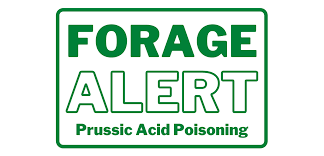Adele Harty, SDSU Extension Cow/Calf Field Specialist
During periods of drought, it is important to consider and be aware of the factors that can be a concern during these conditions, specifically nitrates and prussic acid. In normal years plant growth is normal, and these compounds do not accumulate to levels that could be toxic to livestock, but when plant growth is inhibited, the risk increases significantly due to the plant not developing at a normal rate.
This article will address prussic acid, or cyanogenic glycosides (HCN), but for more information on nitrates, check out our publication, Frequently Asked Questions – Forage Nitrate Toxicity in Ruminant Livestock. Prussic acid is easier to manage and not found in as many plants as nitrates, but caution is especially necessary after a killing frost.
Symptoms of Poisoning
Most frequently, dead animals will be found before symptoms are observed. Within the rumen, the HCN is very rapidly converted to cyanide and absorbed into the bloodstream. Symptoms include nervousness, increased respiration, muscle twitching and trembling, foaming at the mouth, blue coloration of mucous membranes, convulsions and death. Prussic acid does not prevent hemoglobin from transporting oxygen, like nitrates, but instead prevents body cells from receiving and absorbing oxygen, and the animal asphyxiates at a cellular level. Prussic acid poisoning is characterized by cherry-red blood, as it is over-oxygenated.
Grazing Considerations
There are only a small number of plants that can contain prussic acid, and they are in the sorghum family. Common forages include sudangrass, sorghum, sorghum x sudangrass hybrids and Johnsongrass. The prussic acid is concentrated in the leaves of these plants, therefore grazing immature plants, or immediately following a frost, can be detrimental. The HCN is highly concentrated in young, immature and leafy plant growth, so beware of regrowth in fields that have been hayed or drought-stressed fields where growth has been stunted.
A general recommendation is that sudangrass should not be grazed until it reaches a minimum height of 18 to 20 inches-tall and hybrids should not be grazed until they reach 24 to 30 inches-tall; sorghums are generally unsafe for grazing until after plants are harvested or fully mature (dormant). Nitrogen fertilizer can also increase HCN levels, similar to nitrates.
If you plan to graze any of the plants in the sorghum family and the plants have suffered a killing frost, wait 10 days to two weeks before grazing. This will allow for the prussic acid to dissipate. If it was only lightly frosted, ensure that the plant height exceeds the recommendations previously discussed and beware of regrowth.
Testing Forage Toxicity
If plants are drought-stressed or have not reached the minimum recommended height, send a representative sample of the field to a commercial lab for testing prior to grazing to prevent livestock losses. Table 1 outlines prussic acid toxicity levels from a laboratory analysis and provides an interpretation of the results.
TABLE 1. TOXICITY LEVELS FOR HCN FROM LABORATORY REPORTS.

Management Practices
Once test results are received, management practices can be implemented to utilize the field. One option would be to swath graze if levels of prussic acid are elevated. This would allow the prussic acid to dissipate prior to the animals consuming the forage and preserve the hay at a slightly higher nutritional value compared to leaving it standing and grazing it after a killing frost. Under most circumstances, silage and hay can safely be fed to livestock. Approximately two weeks after a killing frost, standing crops would be safe to graze.
There are some important differences between nitrates and prussic acid, but it is important to take precautions when utilizing feeds that could contain one or both compounds.














